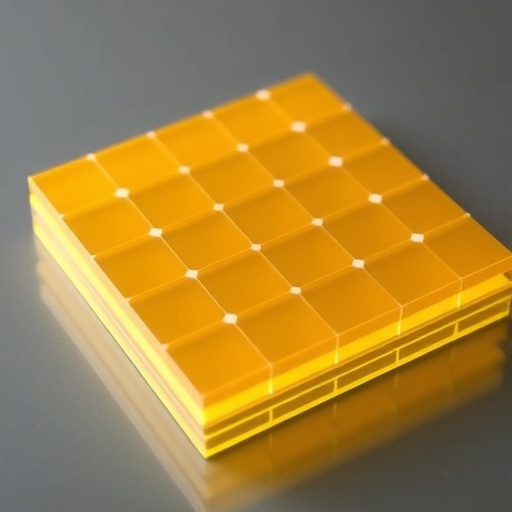In the realm of renewable energy, the quest for efficient and cost-effective materials for solar energy conversion has become a focal point of intense research. Among the various types of solar cells, dye-sensitized solar cells (DSSCs) offer promising advantages due to their low production costs and the use of non-toxic materials. Recent advancements have highlighted a significant breakthrough involving a novel counter electrode material composed of NiFe₂O₄ embedded in a bamboo-derived dual-phase activated carbon composite. This innovative material is poised to enhance the performance of Pt-free dye-sensitized solar cells.
Dye-sensitized solar cells operate on the principle of utilizing light-absorbing dyes to generate electrons, which are then transferred through a semiconductor to create electrical energy. Traditionally, these cells have relied on platinum (Pt) as a catalyst for the redox reactions taking place in the electrolyte. However, the high cost and scarcity of platinum pose significant barriers to the scalability of DSSCs. This has sparked interest in exploring alternative materials that can provide similar or enhanced catalytic activities.
The research team, led by Annamalai et al., embarked on an extensive study of NiFe₂O₄ as a viable alternative to platinum. Nickel ferrite (NiFe₂O₄) has gained attention due to its remarkable electrochemical properties, high conductivity, and abundant availability. In their study, the authors synthesized a dual-phase activated carbon composite derived from bamboo and integrated NiFe₂O₄ into this matrix, creating a counter electrode that exhibits enhanced electrochemical activity.
The choice of bamboo as a precursor for activated carbon is particularly noteworthy. Bamboo is a rapidly renewable resource, making it an environmentally friendly choice for creating high-performance materials. The carbon derived from bamboo not only provides structural integrity but also enhances the overall conductivity of the composite. By combining bamboo-derived activated carbon with NiFe₂O₄, the researchers have developed a composite that shows promising characteristics for use in solar cells.
The dual-phase structure of the composite plays a crucial role in improving the charge transfer efficiency. The unique arrangement facilitates the rapid movement of electrons, which is essential for effective electrochemical reactions. The synergistic effect between the NiFe₂O₄ and the activated carbon enhances the kinetic performance during the redox processes, thereby contributing to improved power conversion efficiencies in the dye-sensitized solar cells.
One of the standout features of the NiFe₂O₄ @ bamboo-derived composite is its operational stability. Stability is a core requirement for solar cell materials, as fluctuations in performance can severely impact their efficiency and lifespan. The research team conducted extensive testing to assess the stability of the composite under various environmental conditions. Their results indicate that the composite maintains its electrochemical performance over extended periods, showcasing its potential for real-world applications.
Further examinations demonstrated that the NiFe₂O₄ @ bamboo-derived composite outperformed traditional Pt-counter electrodes in terms of catalytic activity. The research also provided insights into the mechanisms that govern the enhanced performance of the composite. Not only does the material facilitate efficient electron transfer, but it also ensures optimal interactions with the dye and electrolyte, making it a formidable contender for future solar cell technologies.
In addition to its performance characteristics, the economic implications of this study cannot be overlooked. The sustainable production of bamboo-derived activated carbon coupled with the use of abundant transition metal oxides like NiFe₂O₄ presents a scalable solution to the issues surrounding cost and material scarcity in the solar energy sector. This breakthrough aligns seamlessly with the global demand for renewable energy solutions that are both accessible and environmentally responsible.
The research team has also highlighted the potential for further optimization of the composite. Although the current findings are encouraging, they believe that there exists a wide array of opportunities to enhance the material properties through fine-tuning the synthesis parameters, exploring composite ratios, or even incorporating additional functional materials. Such iterations could lead to even greater efficiencies and broaden the application scope of the technology.
Moreover, there is a significant opportunity for interdisciplinary collaboration in this field. Materials scientists, chemists, and engineers can work together to explore various biomaterials and transition metal oxides to innovate further in the realm of counter electrode research. The insights gained from the NiFe₂O₄ @ bamboo-derived composite serve as a compelling case study for such collaborative efforts aimed at addressing the challenges of energy conversion and storage.
As the demand for sustainable energy sources continues to escalate, findings like those presented by Annamalai and colleagues spark hope for a more sustainable future. Their work not only contributes to the fight against climate change but also lays the groundwork for further exploration into cost-effective materials that can be employed in renewable energy applications.
In conclusion, the advent of the NiFe₂O₄ @ bamboo-derived dual-phase activated carbon composite represents a significant milestone in the pursuit of alternative materials for dye-sensitized solar cells. This innovative research not only challenges the traditional reliance on platinum but also champions the integration of renewable biomass resources into advanced technology. As this field continues to evolve, researchers and industries alike are inspired to rethink the materials used in solar energy conversion and to embrace a collaborative approach toward sustainable energy solutions.
Subject of Research: Development of NiFe₂O₄ @ Bamboo Derived Dual Phase Activated Carbon Composite as a Counter Electrode for Pt Free Dye Sensitized Solar Cells.
Article Title: NiFe₂O₄ @ Bamboo Derived Dual Phase Activated Carbon Composite as a Counter Electrode for Pt Free Dye Sensitized Solar Cells.
Article References:
Annamalai, T., Venkatesan, D., Vinayagam, P. et al. NiFe2O4 @ Bamboo Derived Dual Phase Activated Carbon Composite as a Counter Electrode for Pt Free Dye Sensitized Solar Cells.
Waste Biomass Valor (2025). https://doi.org/10.1007/s12649-025-03233-z
Image Credits: AI Generated
DOI:
Keywords: Dye-sensitized solar cells, NiFe₂O₄, bamboo-derived activated carbon, counter electrode, sustainable energy, renewable materials.




